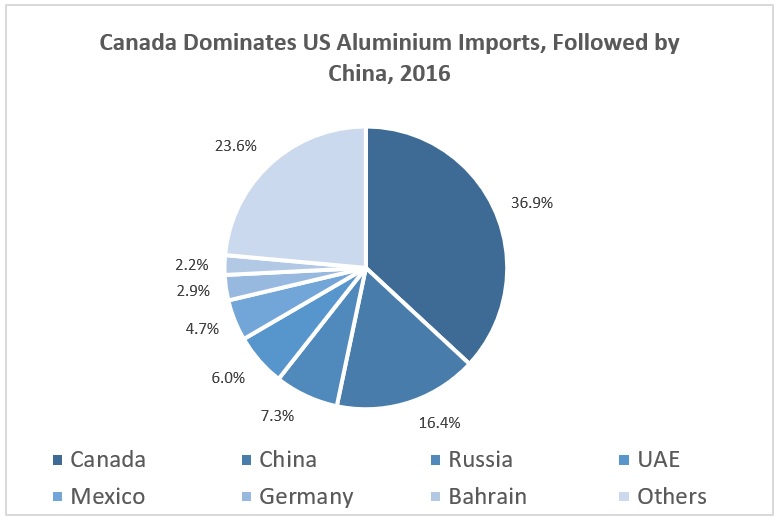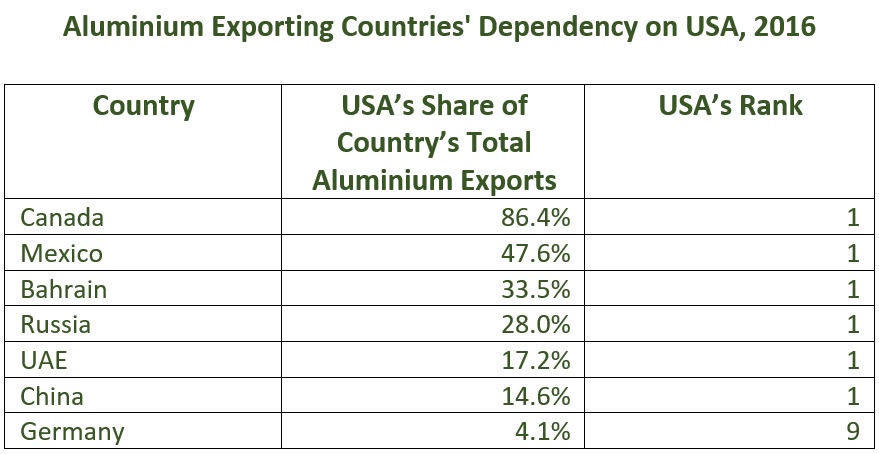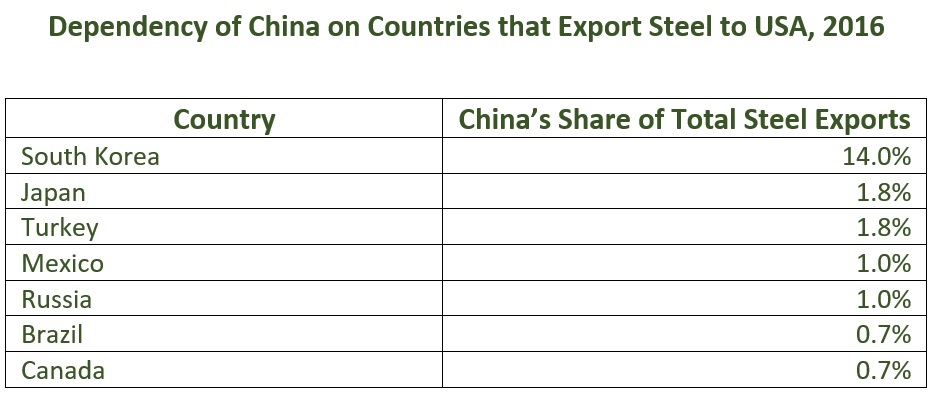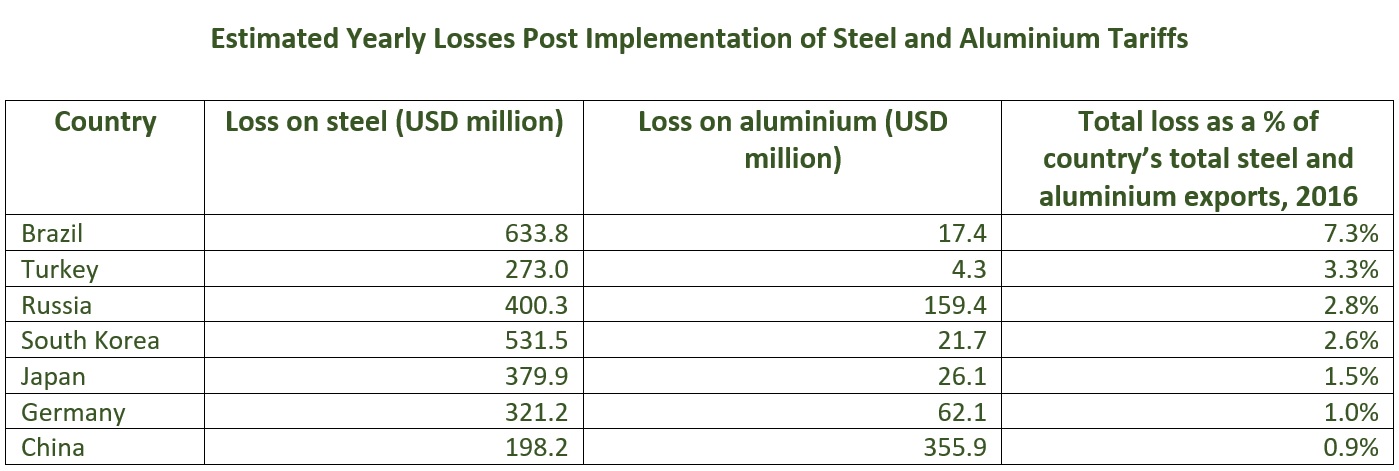Will President Trump’s Decision to Tax Steel and Aluminium Imports Really Benefit the USA?
|
President Trump has announced tariffs on US imports of steel (a tariff of 25%) and aluminium (10%) from all countries except Canada and Mexico, with effect from 23 March 2018. Given that the USA depends on imports for around 30% of its domestic steel demand and around 90% of its aluminium demand, this decision could significantly impact the US economy and also countries that depend on the USA for steel and aluminium exports. |
|
Brazil is likely to be the most affected, followed by Turkey, Russia, and South Korea, with a relatively smaller impact on China. Retaliations are already being discussed, focused on major US exports (e.g. soybean, tobacco, metallurgical coal, and stainless steel). However, the medium-term impact could be worse if a trade war is triggered, affecting global trade at large. |
|
What Prompted the Decision and Who Are the Likely Victims? |
|
The USA’s domestic steel and aluminium industry is constrained by the flooding of cheap foreign steel and aluminium into the country. President Trump signed proclamations on 8 March 2018 to impose a tariff of 25% on steel imports and 10% on aluminium imports, promising to protect the US steel and aluminium industry through free and fair trade. The tariffs will come into effect on 23 March 2018. The President had originally planned tariffs on all countries that export steel and aluminium to the USA. However, due to heavy criticisms by republican lawmakers and threats of a trade war, he exempted Canada and Mexico temporarily, under the condition that the two countries sign the new NAFTA that focuses on reducing the USA’s trade deficit with them. President Trump also mentioned that the tariffs could increase or decrease depending on the country, and that he might exempt certain countries if needed. |
|
The USA is the largest steel importer in the world, despite importing only around 33% of its domestic steel demand in 2017. However, this import dependency has been growing: in 2009, imports accounted for only around 23% of steel demand. As of 2017, Canada accounted for the largest share of the USA’s steel imports, i.e. around 16%, followed by Brazil (13%), South Korea (10%), Mexico (9%), and Russia (9%). On the other hand, the US aluminium industry was much more heavily dependent on imports: domestic production met only around 10% of demand in 2017. Canada dominated the USA’s aluminium import market (36.9%), followed by China (16.4%) and Russia (7.3%) in 2016 (latest data available). |
|
|
|
Source: Department of Commerce, USA |
|
|
|
Source: UN Comtrade |
|
Note: US aluminium import figures for 2016 are the latest data available |
|
What Are the Implications for the USA and Its Import Partners? |
|
As per industry sources, the real risk of these tariffs is not only an increase in steel and aluminium prices, but also a threat to the entire system of global trade that the USA has helped build. |
|
Just hours after President Trump’s announcement, Asian share markets fell (Japan’s Nikkei by 2.4% and Hong Kong’s and South Korea’s indexes by 1.6%). The share prices of Asian steel companies also declined (South Korea’s Posco by around 3% and Japan’s Nippon Steel by around 4%). This indicates a possible threat to the other countries, given the fall in exports to the USA alongside uncompetitive pricing. |
|
Among the countries that export steel and aluminium to the USA, Brazil and Turkey have the strongest dependency on steel exports (since Canada and Mexico are exempt from the tariff) while Bahrain and Russia show the strongest dependency on aluminium exports, with the US being the largest export partner. |
|
As for Canada and Mexico, although they are currently exempt from the tariffs, the future impact on them remains uncertain. Economists believe that it could take months or perhaps years for the USA, Canada, and Mexico to agree on the conditions in the NAFTA. |
|
|
|
Source: Department of Commerce, USA |
|
|
|
Source: UN Comtrade |
|
China’s steel industry will be affected by new tariffs not only directly (although the USA accounted for only 1.2% of Chinese steel exports in 2016), but also indirectly through global markets. As the world’s largest steel producer (accounting for nearly half of global steel production in 2017), China has flooded world markets with steel, driving prices down and intensifying pressure on producers in the US and Europe. China exports steel to many countries that themselves export steel to the USA. The new tariffs’ indirect impact has already been reflected in the fall in the share prices of China’s steel and aluminium companies (Baoshan Iron and Steel by around 3% and Hesteel and Beijing Shougang by less than 1%) just hours after Trump’s announcement. South Korea could be the largest contributor of this impact. The top five contributors excluding Canada and Mexico account for a combined share of almost 20% of Chinese steel exports. |
|
|
|
Source: UN Comtrade |
|
|
|
Source: Compiled by UZABASE based on calculations by Euler Hermes Group |
|
The new tariff could also affect the US economy, given that many industries in the USA depend heavily on steel and aluminium, including the USA’s largest industries such as automobile manufacturing (around 40% of domestic steel demand), construction (26%), and energy (10%). As per the Aluminium Association in the USA, current capacity is insufficient to meet the full US domestic requirement of aluminium. The associated increase in the end markets’ production costs will either have to borne by the companies themselves or passed onto customers to maintain profitability. The situation will worsen if these industries are export-dependent, as their competitiveness in the global market will be weakened. The likely outcome will be adverse impacts on domestic price levels, company profitability, or the balance of payments, as reflected in the fall in the US stock market just hours after the announcement. |
|
Although the share prices of steel companies in the US increased (AK Steel Holding’s by 2.8%, US Steel Corporation’s by 2.3%, and Nucor’s by 1%), the share prices of the companies that depend on steel and aluminium, which represent a considerably larger share of the US economy, fell following the announcement (share prices of Ford, Caterpillar, and Boeing each fell by around 3%). |
|
In addition, while one of the objectives of the new tariffs is the creation of more jobs in the domestic steel and aluminium industry, as per industry sources, the effect on the overall economy could be a rise in unemployment levels. Steel-dependent industries employ around 80 times as many people as steel-producing industries, and the impact of increased steel prices on the former could lower employment. In 2002, President George W. Bush decided to impose a tariff of 30% on steel imports, and it led to a fall in the employment level by around 200,000 (0.14% of the labour force as of December 2003) in the US manufacturing industry since its implementation, so the tariff was removed after just 18 months. |
|
Possible Countermeasures by Other Countries and Their Impact on the USA |
|
To protect themselves from import tariffs, the countries mainly at risk of impact have already announced retaliations. As these countries are among the USA’s top five export partners, their actions might adversely impact the US economy. |
|
China (8.1% of total US exports in 2016): China’s Steel and Metal Association has asked the government to retaliate against the USA, citing imports ranging from stainless steel to coal and agricultural products including soybean. China is one of the USA’s major export partners for soybean (around 57% of total US soybean exports in 2016). Any decision by China to impose tariffs on agricultural products from the USA poses a risk to the US agricultural sector. If China focuses on consumer electronics and chip-makers, major companies such as Apple, Qualcomm, and Intel that have operations in China stand to lose. |
|
Brazil (2.1% of total US exports in 2016): Brazil has reminded US officials that it is the largest buyer of US metallurgical/med coal (absorbing 12.8% of US med coal exports in 2017), so that the USA would not rule out a retaliation. |
|
EU (18.7% of total US exports in 2016): The USA was the destination for around 15% of Europe’s steel exports in 2017. The EU announced it will retaliate against Trump’s decision and impose a tariff on US exports of orange juice, tobacco, Kentucky bourbon, and Harley-Davidson motorcycles to escalate a trade war. As the EU has not yet indicated what levels of tariff will be imposed, it is unclear what the economic impact would be. Of the USA’s total tobacco exports, 7.7% was traded with EU countries in 2016. |
|
In conclusion, a possible trade war between global heavyweights might harm not only specific economies, but also the world economy as a whole by threatening the international trade landscape. |









